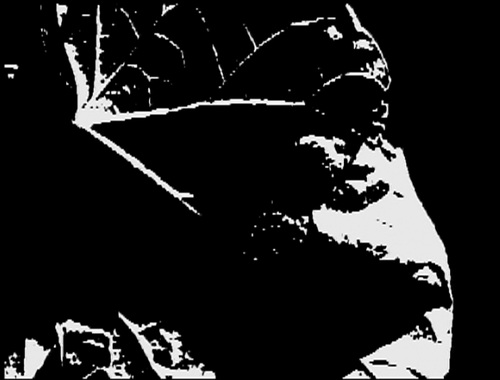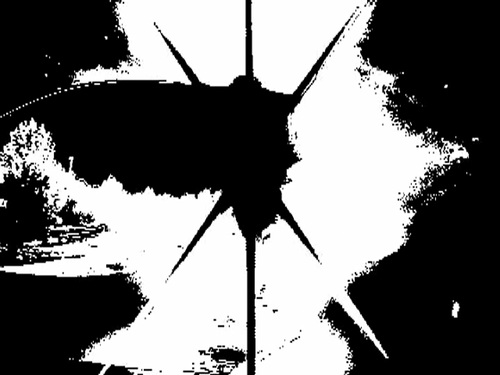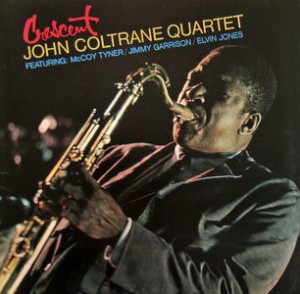From the Chicago Reader (April 29, 1988). Note: The Andrew Noren stills are copyrighted by his estate. — J.R.
THE LIGHTED FIELD
*** (A must-see)
Directed by Andrew Noren.
I’m a light thief and a shadow bandit. I deal in retinal phantoms. Film is illusion, period, however you choose to see it — shadows of human delights and adversities or raging conflicts of emulsion grains. We see only “films” of films, as all of our sight and sensing is illusion, the phantom movies of our encounter with the world, which, remember, is equally phantom, trompe l’oeil of that clown and ghostmeister, the sun.
The lovers, light and shadow, and their offspring space and time are my themes, working with their particularities is my passion and delight. — Andrew Noren
The difference between narrative and nonnarrative filmmaking is a little bit like the difference between team sports and individual exercise. In contrast to a collective game with a beginning, a middle, and an end, personal exercise tends to be more rhythmically repetitive, involved more with process and with cycles than with development, and moves with a steadier pulse that eschews the more unpredictable dynamics of drama and suspense.
Andrew Noren’s lovely 59-minute The Lighted Field — part five of his ongoing work The Adventures of the Exquisite Corpse, which has engaged him over the past two decades — belongs mainly to the nonnarrative realm. The experience it imparts is at once so invigorating and soothing that it makes one doubly aware of how monotonous and limited — as well as limiting — an exclusive diet of narrative films can be. The conventional wisdom about nonnarrative, “experimental” films is that they’re esoteric, difficult, boring, and specialized, but this one is so pleasurable and engrossing that it makes most ordinary movies I’ve seen this spring look complacent, ugly, and dull by comparison. You don’t have to worry about “getting the point” with this kind of movie, as one conventionally does with narrative (a process that sometimes has more to do with work than with play). The Lighted Field is an exercise in direct sensual pleasure, and that is the point.
“If it sounds good, it is good,” Duke Ellington once remarked, and Noren’s visual music demands to be experienced and judged just as simply. One certainly doesn’t have to be initiated or educated in any particular way in order to enjoy this kind of moviemaking, despite the self-conscious exertions and categorizing of a culture that will tell you otherwise. The Lighted Field is silent and in black and white, and part of its triumph is to make those facts necessary and welcome preconditions rather than drawbacks to its cornucopia of treasures. Noren’s subject matter, moreover, is mainly as mundane and everyday as one can imagine. It can more or less be summed up as the life, light, weather, and ordinary activities that go on in a city apartment and neighborhood, and in and around a house in the country — minute by minute, day after day, and year after year.
My own knowledge of Noren and his work is pretty minimal. All I’ve seen of his previous work is Charmed Particles (1977), also silent and black and white; it’s part four of The Adventures of the Exquisite Corpse, and it runs for 90 minutes. Parts one through three are in color, and according to Gail Camhi in Film Culture, Noren’s shift to black and white in the 70s was motivated by “the industrial squeezes put on film artists and the disappearance of good Kodachromes.” Camhi implies that this change entailed a widening rather than a narrowing of Noren’s tonal palette — which is less implausible than it sounds to anyone who’s seen what Noren’s black-and-white films look like: they offer an infinite spectrum of gradations that no publicity photograph can come close to conveying.
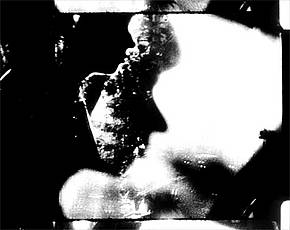
Should these developments in Noren’s work be seen as improvements or regressions? I’m not at all sure. While part of me prefers the greater simplicity and clarity of Charmed Particles, I have seen the earlier installment two or three times and The Lighted Field only once, and it would be presumptuous of me to form anything more than a preliminary impression at this point. All I can say now is that the new film gives me every bit as much pleasure as the old one, and a little less confidence that this pleasure represents the sum total of what the movie has to offer. One way of illustrating this would be to say that a basic theme of both films is that elements of countryside and nature are sometimes found in the city, and the presence of the actual countryside in The Lighted Field tends to complicate this somewhat.
But this is basically conceptual quibbling. More immediately, the film begins with glittery light jiggling on dark water (whether it’s in the city or country couldn’t matter less), and continues with prismatic lights and clouds; shots of a man sleeping on his back over an extended period (as we can tell from the jump cuts and racing shadows); a family photograph; smoke or vapor seen through a window; a series of dials being set on a machine; the turning reels of what looks like a film projector; a woman putting on lipstick; and then a skeletal X ray of the same woman putting on lipstick.
Listing the subjects of these shots doesn’t go very far in conveying what the film is like, any more than, say, C, B-flat, C, G, F, and G tell you much about the first three bars of Dinah Washington’s rendition of “You Go to My Head.” The glittering, trembling, pulsating rhythms of many of these shots are just as important, not to mention the overall dance of life they describe. The leafy shadows on a wall or sidewalk in a typical Noren shot describe not only a pleasing graphic pattern, but a cosmic undulating miasma of shifting energies, often sped up to become visible through time-lapse photography, spelling out a kind of delicate latticework in constant intricate motion.
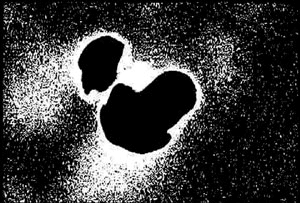
Indeed, Noren’s major poetic insight is to discover such ceaseless patterns all around us, at every instant, providing a kind of ecstatic illumination of everyday moments that could provisionally be traced back to hallucinogenic drugs and the mystical meditations of the 60s, when Noren got started as a filmmaker, but could just as easily be linked to certain earlier poetic and aesthetic traditions as well. What Noren refers to in the quotation that prefaces this review as “the phantom movies of our encounter with the world” is actually quite precise rather than merely suggestive — a matter of the shifting coordinates of light, shadows, and optics. In an earlier portion of the same text, Noren provides a striking visual equivalent to this process in an extended stretch of mantralike verse that reproduces the same pulsing and syncopated rhythms — a passage that begins:
Come shadow, come and take this shadow up
Come shadow shadow, come and take this up
come, come, shadow, and take this shadow up
come, come, and Shadow, take this shadow up
come, up, come shadow and take this shadow
and up, come, take shadow, come this shadow . . .
Considering the quantities of bad art that have grown out of (or at least pointed back toward) hallucinogenic and meditative perceptions in the 60s and early 70s, it is worth recalling that some genuine achievements remain, a group of works that might include Noren’s ongoing oeuvre as well as John Coltrane’s “Wise One” and “A Love Supreme” and Rudolph Wurlitzer’s first novel, Nog.

One thing that distinguishes Noren’s work from the roughly contemporary experimental work of Stan Brakhage, Jonas Mekas, and Michael Snow is its relative indifference to both history and what might be described as male possessions. The presence of household members, pets, and the filmmaker’s own shadow never signifies autobiography or ownership in Noren’s films in the way that Brakhage’s family, Mekas’s friends, and Snow’s objects (machines, art, and furniture) in their own films do. In Noren’s film such items constitute the filmmaker’s immediate environment and might be said to serve as a partial setting for his visual concerns — his preoccupations with light, shadows, and textures — but they are not usually treated as trophies or scrapbook entries.
If we must speak of other filmmakers in relation to Noren, Josef von Sternberg and F.W. Murnau, despite their exclusively narrative contexts, may in fact be more relevant: the mottied shadows and weblike decor of Sternberg, the voluptuous uses of water and pulsating light and smoke in Murnau. And if Noren’s films have an ideological or political “message,” it might be that the sort of visual splendors that Sternberg and Murnau most often contrived in film studios are available to everyone everywhere — right under our noses, in fact.
The shadow of a subway train speeding across a deserted platform; the rocking pan of a camera back and forth across a palpitating lawn out of Cezanne; the manic impact of the wind on a flapping bed sheet or window curtain, across the leaves on a tree or the pages in an open book; two dogs diving in reverse from a river back to an overhead bridge; a little boy playing with a cat and dollar bills; a couple kissing; a teenager sleeping with a dog; silvery light speckling a floor or atomizing on quivering water; a riotous street of glass reflections, cars, pedestrians, and shadows. And the nicest part of this visual workout and sensual feast is that nobody wins or loses or keeps score.


